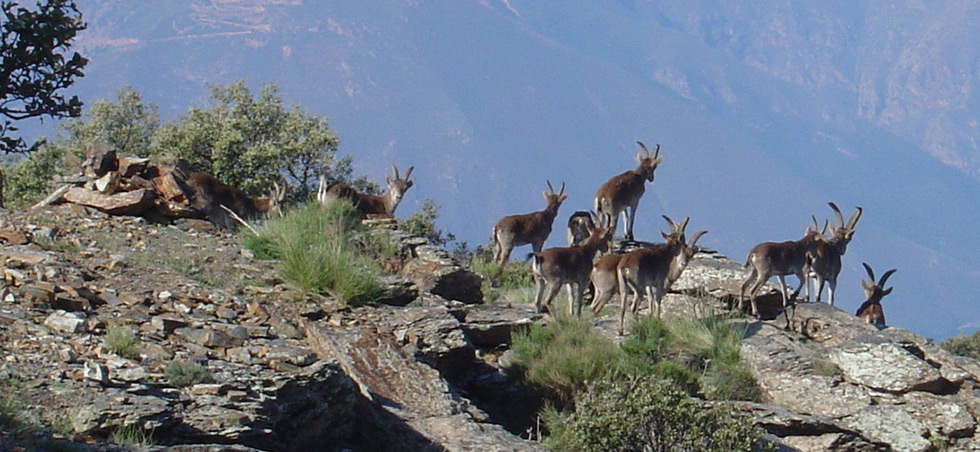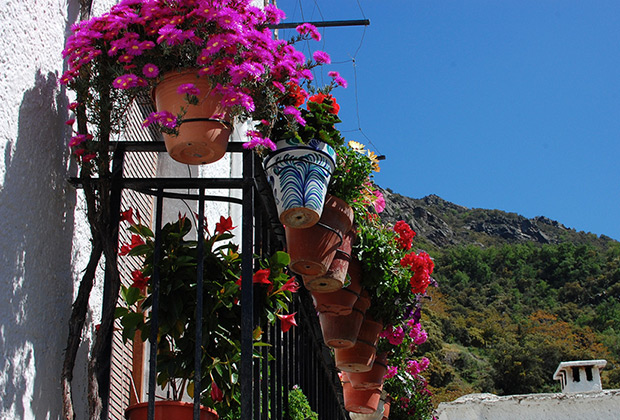






From the peaks of Spain's highest mountains to the southern sierras and the Mediterranean beyond, Las Alpujarras is one of the most enchanting and beautiful regions in the world.

Between the highest mountains in Spain and the Mediterranean Sea, Las Alpujarras is one of the most enchanting and beautiful regions in the world.
Some call it Las Alpujarras, others La Alpujarra: whichever you prefer, it’s a joyous land of sunshine, snowy mountains and some of the most splendid scenery imaginable.
From the spectacular ‘lunar’ terrain and snow-capped peaks (which rise above 10,000 feet), the mountain range of the Sierra Nevada slopes southwards, traversed by deep, wooded river gorges and truly wonderful countryside.
Pine forests on the higher slopes give way to chestnut, walnut and cherry trees, which in turn give way to almonds, olive groves and vines, then to orange and lemon, pomegranate and quince in the valleys below.
The mountains rise up once more in La Contraviesa, like a last wave before the coast, only to fall steeply into the tropical coves and palm-fringed beaches of the Mediterranean, far below.
The high mountains have their own special beauty: wild and brooding in winter, they come alive in early summer with the scents of wild herbs and the spectacle of tiny, brilliantly coloured flowers, many of them unique to Sierra Nevada.
These mountains have a power which everybody who comes here feels. Perhaps it is in the quality of the light, or the brilliance of the stars at night, the purity of the mountain air or the crystal-clear spring water?

Altitude and sun have combined to evolve more endemic botanical species in Las Alpujarras than in all the rest of Europe.
Mountain goats, wild boar, foxes, eagles, goshawks and partridge inhabit the sierras. Mules and donkeys still labour in the fields, sheep and goats graze the hillsides. Trout fill the rivers.
From the snows to the sea, there are panoramic views in every direction, from the peaks of Veleta and Mulhacén to the southern sierras and the Mediterranean beyond. At sunset, the Rif mountains of Morocco are sometimes clearly visible, 200 kilometres away across the sea.
There is something else too … something indefinable. To the Spanish, “Las Alpujarras” rings of magic, and there is a natural power which these mountains have and which everybody who comes here feels. Perhaps it is in the quality of the light, the brilliance of the stars at night, the purity of the mountain air or the crystal clear spring water?
Whatever it is, it is something which remains more than just the beautiful countryside, the time-honoured local customs, the peacefulness and the warm Andalusian sun …
The Moors took refuge in these hills and resisted here for well over a hundred years after they were expelled from Granada in 1492. Their legacy is to be seen everywhere.

The Moors took refuge in these hills and resisted here, maintaining their customs and way of life for well over a hundred years after they were expelled from Granada in 1492 by their Christian conquerors. Las Alpujarras was their final battlefield in Spain.
Their legacy is to be seen everywhere: in the distinctive architecture of the mountain villages and in the intricate system of irrigation waterways which they built and which still keep the landscape green and fertile, fed by the snows melting high in the sierras above.
The architecture of the little mountain villages is unique in Europe and is identical to Berber originals in the Atlas mountains of Northern Africa. With dwellings characterised by flat roofs and prominent chimney pots, the villages were built by the Berber settlers whose creation imitated and followed the half-natural, half-man made designs of their own mountain lands.
Beautiful in their simplicity, the villages appear to tumble haphazardly down the steep hillsides, connected by a labyrinth of narrow, winding cobbled streets. A picture to behold, glistening white in the sun, roses and geraniums spilling from every nook and cranny. Bubión and Capileira are classic examples.
A joyous land of sunshine, snowy mountains and some of the most splendid scenery imaginable, there are more endemic botanical species in Las Alpujarras than in the rest of Europe combined.
Just a few kilometres from the Costa Tropical, the climate is typical of Andalucía – warm and sunny with crystal-clear blue skies throughout most of the year. The mountain air is the cleanest in Europe and, because of the altitude, the heat in mid-summer is not oppressive, as it can be in much of southern Spain. It can be cold in the higher mountain villages in winter, but incredibly beautiful too.
As the seasons change, so does the appearance and character of this magical mountain world. Winter is the most dramatic. Snow lies thick on Sierra Nevada, occasional rains enrich the green life of the earth, amazing cloud ‘dragons’ swirl up the valleys and the sunsets are a joy. A log fire at night is a must!
Late January sees the first swathes of blossom: pink and white almonds, and soon spring arrives for real, putting on a Monet show of colour in the valleys. The sun warms the countryside and there is a fresh liveliness in the pure mountain air.
Summer time is fiesta time! Each little village celebrates its own festival and for some this marks out an itinerary in itself of dance and fireworks, saints and wine. For others, the high mountain villages are a haven away from the coastal heat.
The gentle peacefulness of autumn follows; rich in colour, usually warm and sunny. Grapes are ripe on the vine, walnuts, chestnuts and mushrooms can be picked by all. Higher up in the hills, the nights begin to cool, while below in the valleys, where the microclimate is semi-tropical, swimming pools are sometimes still in use throughout October.
The historic city of Granada is “just down the road”, skiing facilities on the north side of Sierra Nevada are now world-class, the Mediterranean coast is less than an hour away. From the snow to the sea … Las Alpujarras.

















Check out our latest special offers and last minute deals on holidays in Andalucía
